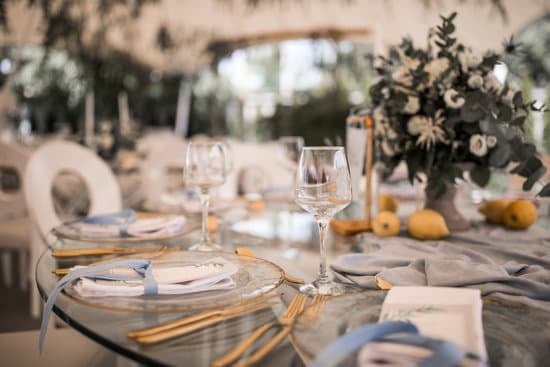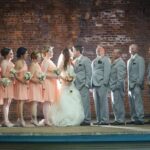The royal wedding holds a special place in the hearts of many, captivating audiences around the world with its grandeur and tradition. One may wonder, how long is the royal wedding? This article will delve into the intricacies of royal weddings, shedding light on their significance and length.
As we explore the history of royal weddings, it becomes evident that these events are steeped in tradition and cultural importance. From the ceremony itself to the elaborate procession and reception, every aspect of a royal wedding holds significant meaning. Understanding the length of time dedicated to each element provides insight into the magnitude of these celebrations.
In this article, we will take a detailed look at the order of events during a royal wedding ceremony and uncover how long each component typically lasts. Delving into traditions, customs, and behind-the-scenes preparations, we aim to provide a comprehensive understanding of the duration and grandiosity of royal weddings. So let’s embark on this journey to unravel the mystique and splendor that surrounds these historic celebrations.
History of Royal Weddings
Royal weddings have always been a spectacle, marked by grandeur and tradition. The length of these ceremonies has often varied throughout history, influenced by cultural norms, religious practices, and the personal preferences of the royal couple. Understanding the historical context of royal wedding ceremonies can provide insight into how long these events typically last.
1. Queen Victoria and Prince Albert: Queen Victoria’s wedding to Prince Albert in 1840 set the standard for modern royal weddings. The ceremony took place at the Chapel Royal in St James’s Palace and lasted approximately an hour. The marriage vows, exchange of rings, and blessings by the Archbishop of Canterbury were all part of this solemn and regal event.
2. Prince Charles and Lady Diana: One of the most iconic royal weddings in recent history was that of Prince Charles to Lady Diana Spencer in 1981. The ceremony at St Paul’s Cathedral was an elaborate affair that spanned over an hour and a half. With a congregation of over 3,500 guests and a global television audience, every detail was meticulously planned to ensure a memorable occasion.
3. Prince William and Kate Middleton: In 2011, Prince William married Kate Middleton at Westminster Abbey in a ceremony that lasted approximately one hour as well. The world watched as the couple exchanged their vows and embarked on their journey as future monarchs.
Each royal wedding has its own unique qualities, but they all share a common thread – a celebration of love wrapped in centuries-old traditions and customs. From grand processions to heartfelt vows, these historic events continue to captivate audiences around the world with their timeless elegance.
The Ceremony
The royal wedding ceremony is a grand and significant event, steeped in history and tradition. From the exchange of vows to the musical performances, every aspect of the ceremony is carefully planned and executed. Understanding the order of events and how long each one typically lasts can give us a glimpse into the magnitude of this occasion.
Here’s a detailed breakdown of the order of events during a royal wedding ceremony:
- Processional: The bride’s entrance and her walk down the aisle with her escort typically lasts around 5-10 minutes, creating an awe-inspiring moment that sets the tone for the entire ceremony.
- Welcome and introduction: The officiant welcomes everyone and gives a brief introduction, which tends to last around 5-10 minutes.
- Vows and exchange of rings: The heartfelt exchange of vows and rings between the couple usually takes approximately 15-20 minutes, showcasing their commitment to each other.
- Readings, prayers, and blessings: Various readings, prayers, and blessings by family members or religious leaders can extend this part of the ceremony to about 15-30 minutes.
- Signing of the register: The couple signs official documents while music plays in the background, taking around 10-15 minutes.
- Recessional: The newlyweds’ exit from the ceremony venue as husband and wife lasts about 5-10 minutes, accompanied by joyous music and applause from attendees.
These sequences contribute to making a royal wedding ceremony captivating yet formal occasion that captures everyone’s attention. Each element has its own symbolic significance and contributes to making this timeless event such a remarkable experience.
The Royal Procession
Duration and Route
The duration of the royal procession is influenced by various factors, such as the distance between the wedding venue and the reception location, as well as any planned stops or events along the way. For example, in the case of Prince William and Kate Middleton’s royal wedding, their carriage procession from Westminster Abbey to Buckingham Palace lasted approximately 15 minutes.
It is essential to note that security measures and crowd control also play a significant role in determining the length of the procession.
Traditions and Customs
The royal procession usually involves a carriage ride for the newlyweds, allowing them to wave to well-wishers who have gathered along the route. In some cases, such as with Prince Harry and Meghan Markle’s wedding, there may also be military involvement, with members of the armed forces lining the streets as a show of respect and support for the couple.
Additionally, it is customary for members of the royal family and wedding guests to participate in the procession either by walking alongside or riding in carriages following behind that of the newlyweds.
Royal Wedding Traditions
Royal weddings are steeped in tradition and customs that have been observed for generations. From the attire of the bride and groom to the ceremony itself, there are numerous customs that make royal weddings truly unique and special. Let’s take a closer look at some of the lengthy customs and traditions that are typically observed during a royal wedding.
Attire
One of the most iconic aspects of a royal wedding is the attire worn by the bride and groom. The bride’s gown is often an intricate and elaborate creation, taking months to design and construct. From the fabric to the intricate lace details, every aspect of the gown is carefully chosen to reflect tradition while also showcasing modern styles. Similarly, the groom’s attire is often traditional, with specific requirements for military uniforms or formal suits.
The Ceremony
The actual royal wedding ceremony is filled with lengthy customs and traditions that have been passed down through generations. From the processional music to the exchange of vows, every moment is carefully planned and steeped in historical significance. The ceremony itself can last anywhere from one to two hours, depending on the specific customs observed by the royal family.
The Wedding Breakfast
Following the ceremony, there is typically a lavish reception known as the “Wedding Breakfast.” This event can last for several hours and includes a formal sit-down meal, speeches from family members and close friends, as well as various forms of entertainment such as live music or dances. The length of this reception can vary depending on the preferences of the royal couple but typically lasts several hours.
These lengthy customs and traditions contribute to making royal weddings truly unforgettable events that capture worldwide attention. From extensive planning to extravagant ceremonies, these traditions serve as a testament to not only the history of monarchy but also its continuing relevance in modern society.
The Reception
Royal wedding receptions are typically extravagant events that last for several hours, and they involve various traditional customs and modern elements. The duration of a royal wedding reception can vary, but it generally lasts for around 4 to 6 hours. This gives the newlywed couple and their guests ample time to celebrate and enjoy the festivities.
During a royal wedding reception, guests are treated to a lavish meal, often consisting of multiple courses. The menu is carefully curated, with both traditional and contemporary dishes that reflect the couple’s tastes and preferences. In addition to the fine dining experience, there are usually speeches and toasts from family members and close friends, adding a personal touch to the celebration.
Entertainment is also a key component of royal wedding receptions. Live music performances, dancing, and other forms of entertainment are common features of these grand affairs. For example, at Prince William and Kate Middleton’s wedding reception in 2011, Elton John performed several songs for the guests, making it a memorable event.
In summary, royal wedding receptions are elaborate events that typically last for several hours. They include a multi-course meal, speeches and toasts, live entertainment, and other special touches that reflect the couple’s unique style and personality.
| Aspect | Details |
|---|---|
| Duration | Around 4 to 6 hours |
| Meals | Multi-course curated menu |
| Entertainment | Live music performances & dancing |
Behind the Scenes
When it comes to royal weddings, the ceremony itself is just the tip of the iceberg. Behind the scenes, months or even years of preparation and planning go into ensuring that everything goes off without a hitch. From selecting the venue to coordinating security details, the logistics of a royal wedding are no small feat.
The length of preparation and planning for a royal wedding can vary depending on various factors, such as the scale of the event and the preferences of the couple getting married. In some cases, it may take several years to plan a royal wedding, especially if it involves coordinating with multiple vendors, securing permits for a large-scale event, and accommodating high-profile guests.
In addition to the logistical aspects of planning a royal wedding, there are also numerous protocol and etiquette considerations that must be taken into account. This can include everything from selecting appropriate floral arrangements to seating arrangements for dignitaries and foreign royals.
Each detail must be carefully planned and executed to ensure that the event runs smoothly. Considering all these factors, it’s no wonder why the preparation and planning for a royal wedding can be an extensive process that requires meticulous attention to detail.
Conclusion
In conclusion, the length and grandiosity of royal weddings have been a hallmark of history for centuries. From the elaborate and lengthy ceremonies to the grand royal processions, these events capture the world’s attention and demonstrate the significance of tradition and heritage. The historical context and cultural importance of royal weddings cannot be understated, as they continue to shape and influence society.
When examining the duration of past royal wedding ceremonies, it becomes clear that these events are not simply a matter of hours but rather an unfolding narrative that can last for days. Each detail is meticulously planned, from the order of events during the ceremony to the elaborate traditions that are observed.
The royal procession, in particular, is a spectacle that showcases the regal splendor and pageantry associated with these momentous occasions. This procession can last for a significant amount of time, giving onlookers ample opportunity to witness the grandeur of the event.
Furthermore, royal wedding receptions also reflect this sense of grandiosity, often lasting well into the night with lavish feasts and entertainment fit for royalty. Behind the scenes, months or even years of preparation and planning go into ensuring that every aspect of the wedding lives up to its regal reputation.
Ultimately, when considering how long a royal wedding truly lasts – whether in terms of time or impact – it becomes evident that these events leave an indelible mark on history and continue to capture the imagination of people around the world.
Frequently Asked Questions
Who Has the Biggest Royal Wedding?
The biggest royal wedding in recent history was that of Prince Harry and Meghan Markle. Their wedding, held in 2018 at St. George’s Chapel in Windsor Castle, captivated audiences around the world with its grandeur and modern touches.
Who Paid for Harry and Meghan’s Wedding?
Harry and Meghan’s wedding was paid for by the royal family, particularly Prince Charles. The cost of security alone was estimated to be around £30 million, with additional expenses covered by the royal family.
What Did Kate Middleton Walk Down the Aisle To?
Kate Middleton walked down the aisle to the music of “I Was Glad” by Sir Charles Hubert Hastings Parry. This piece holds significance as it was also used in the weddings of Queen Elizabeth II and Princess Margaret, adding a traditional touch to Kate and William’s ceremony.

I have been involved in marriages for over 20 years helping couples and singles understand more about them.





